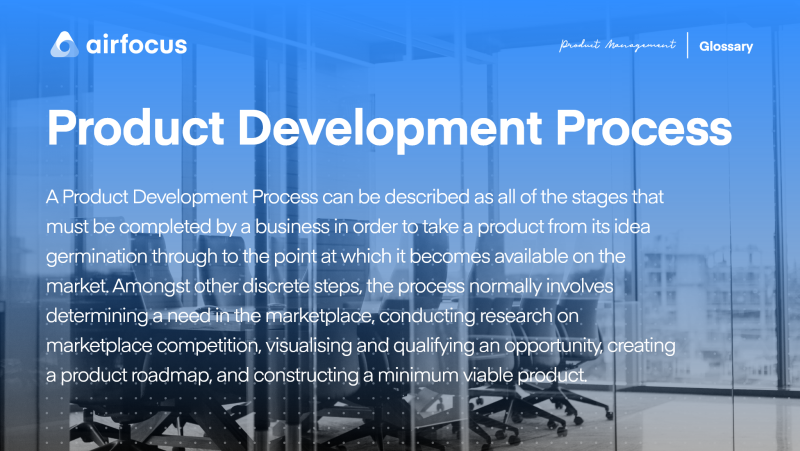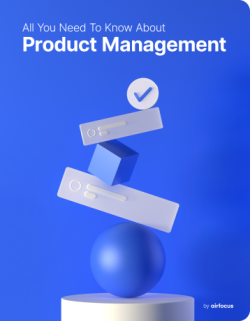Product Development Process
What is the Product Development Process?
Definition of a product development process
The product development process combines all of the steps required to take a product from the concept stage to a readily available product within your target market.
Perhaps the most pivotal role in the entire product development process is the Product Manager or Product Development Manager (PDM). ´
With them being responsible for the success of a business’s products, they are normally the driving force in the development process.
Nevertheless, departmental cooperation encompassing design and development, marketing, finance and sales, and testing, is essential.
The role of the Product Manager nonetheless is overarching since it is they who will draw together the departments of the organization, use the product roadmap to promote strategic objectives and have oversight of the development team’s operations.
Phases of the Process
There are a variety of specific ways by which the process of the product’s development can take place. Broader concepts that tend to appear in each case, and are widely accepted are:
Ideas This is the phase where the business harvests ideas. The organization may even have an Idea Management System with specific channels in place to collect ideas from its workforce. The leadership team will want to encourage a constant stream of future concepts - both from staff and from any other source - and a management framework facilitates this. Brainstorming sessions and lateral thinking exercises can be conducted as well as market research through surveys and interviews.
Research and evaluation In the first instance at this point, work starts on weeding out ideas that are wild, inappropriate, or even fanciful. Work can then begin with evaluating possibilities. Things like market research, further consumer feedback, identifying prospective customers, and assessing competition, are all components of attempting to determine the viability of the idea. Certainly, a key concept that is taken into consideration will be whether or not the concept aligns with the business's strategic objectives. If it does not, and it cannot be modified to meet those aims, the idea will be cast aside.
Planning Once an idea has passed the viability test, planning for the project begins. Financing will be set in place with budget allocations for different product strands, staff resources and tasking designations worked out, product specifications set, and engineering methods described. This is where the product moves from being largely conceptual to being more tangible.
Development This is the exclusive vicinity of the development team. Various aspects of the product’s realization will occur through operations such as framework development, dependency planning, sprints, project strand merging, quality assurance, etc. Beta testing might occur so that the product can be assessed in a real-world environment and feedback from consumers and the market is possible. This is where the minimum viable product is formalized. A prototype might also be made available to stakeholders. Technical documentation pertaining uniquely to the product will ideally have been written as the project progresses.
Market preparation Sourcing materials, scaling, channels for distribution, pricing points for the product, and a product launch plan are all implemented in order to prepare the product to enter the marketplace. Financial, marketing, and sales documentation will be collated in this phase.
Finally, the product will then be launched into the marketplace. Depending on the product and the business, the stages of development may overlap. Although the phases tend to begin sequentially and are interdependent, it is often expedient to begin a phase before the previous one has finished. Market preparation, for example, can start before the product has been completely developed.
Established Practice in Product Development
Choose a methodology There are a number of frameworks that have been evinced to develop products for business. Utilizing one of them is an astute place to start. Product Development grows in complexity as an idea travels through the development process from concept to reality. Following a framework is essential for retaining effective oversight and delivery of the project. Examples of concepts in existence are the IDEO approach, the BAH model, the Stage-gate model, the Lean Start-up approach, and the Exploratory Product Development approach.
Consumer understanding and attitude The seed of an idea may have been spawned in any manner, from a moment of clarity of a single individual to the collaboration of many groups based on a gap in the market. In any case, having an understanding of the attitude and behavior of the product’s consumers is a major advantage. Integrating consumer intelligence throughout the development wherever possible will serve to keep the product relevant and market-fit, from early validation of the concept to real-world beta testing in later development.
Idea generation Be open to entertaining ideas from anywhere within the organization’s workforce. A business relies on a steady stream of incoming ideas. Furthermore, any member of any team can hit upon an idea for a great product, and dismissing any individuals or groups can mean missing a successful commercial opportunity. By creating an initiative or a system to capture ideas across the whole organization, no opportunities go unchecked and the workforce will feel more fulfilled and motivated.
Communication Keep avenues of communication within the organization robust. This is so expertise and knowledge can be readily transmitted from person to person, across teams, across departments, and throughout the business. This is a common failing of many organizations and things like missed opportunities, accumulated technical debt, failure to share innovation, poor mentoring, and deficient leadership, are among the issues that can arise.
Timelines and deadlines
Be realistic and pragmatic when laying down development timelines. Using roadmaps to guide the progress of the product can help to create efficient working schedules. These can also aid in prioritizing the right initiatives in the right order as well as determining relationships between the project’s dependencies.
The product development process is driven by the Product Manager, who is ultimately responsible for the success or failure of the product. That said, the product development process requires input from multiple departments.
Product Managers act as the strategic directors of the development process to ensure each department is aligned with the product goals and can work as a cross-functional unit.
Several popular systems have been created to aid the product development process, including:
Design thinking - Design thinking is a framework designed to instill maximum value into a product by empathizing with the user’s wants, needs, and pain points.
The New Product Development (NPD) Framework - This framework is a typical composite approach used to develop physical products.
3 Pillars - This simplistic framework breaks the development process into three distinct areas — product discovery, product planning, and product development.
Product development stages
There are many product development systems that product teams can use, and many of these systems have similar stages.
Ideation
Before the team can develop a product, they first need to figure out what that product will be. This stage is an intensive process because it involves a wide range of research activities including:
Identifying the target audience
Competitive analysis to see if competitors already offer what you’re looking to create
Identifying required functionality
Product definition
The product definition stage allows teams to refine their product strategy. This stage is occasionally referred to as scoping or concept development.
The team will need to define specifics at this stage, including:
Business analysis - Business analysis involves mapping out distribution strategy, ecommerce strategy, and deeper competitive analysis. This step will help build a clearly defined product roadmap.
Success metrics - Success metrics help you gauge if the product was successful. Create these metrics early so you can evaluate and measure success once the product launches.
Value proposition - What problem is this product solving? How does it differ from existing products on the market? You can start shaping your marketing strategy by identifying the product’s main value.
Marketing strategy - How do you plan to market this product? You can use everything you’ve discovered during this stage to shape your marketing strategy. These plans will likely change throughout the process, but it’s important to establish marketing intentions early to help shape the development process.
Prototyping
Early-stage prototypes may just be scribbles on a napkin, but they’re an important part of the development process. Even the simplest wireframes can unearth potential problems early on, making it easier and cheaper to fix the issue. Early prototypes can also be used for market research and testing.
Initial design
The product will likely go through many iterations. At the initial design stage, you simply want to connect with stakeholders and gain user feedback to help shape the development using actual, hands-on usage.
Validation and testing
Before releasing your product, you need to make sure it functions as intended and offers real value to the user. To refine the product, you’ll need to go through multiple testing stages. Once validation and testing are complete, you’re ready to hit the market!
Product creation
Product creation is a tricky thing to master. No matter what market you’re looking to target, it’s a fast-moving and highly competitive environment.
To create brand new products that perform well, you need to:
Position yourself as a unique option - How does your product differ from existing products?
Consider charitable partnerships - Businesses that align with charitable causes will often gain more traction than those that don’t.
Focus on quality - Never rush your development process or skimp on quality. The higher your product's quality, the more likely consumers are to buy it.
Refine your product early - If you rush a product to market, your potential customers will often wait to see how future refinements improve it. During that time, you may not have enough sales to warrant keeping the product on the market.
Get feedback - Involve your target audience in the development process! Find out what customers want and need directly, rather than only using market research.

General FAQ

Glossary categories
Experience the new way of doing product management

Experience the new way of doing product management








